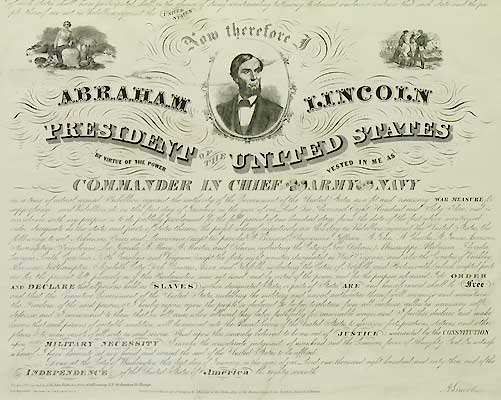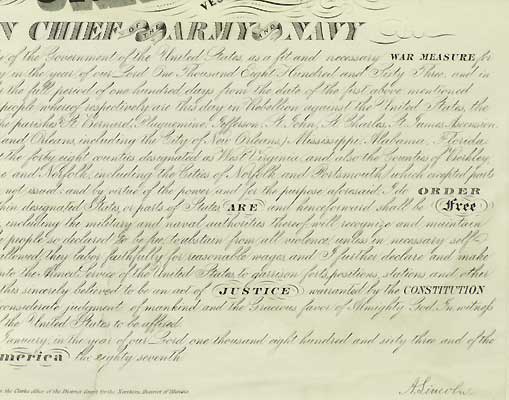Sweden abolished slavery (1335)France abolished slavery (1794)
France resumed slavery (1802)
France abolished slavery, again (1848)British abolished the slave trade (1807)
British emancipated all slaves in all colonial possessions (1833)Mexico abolished slavery (1829)
Russia abolished slavery (1861)
Abraham Lincoln (1809-1865)
16th President of the United States (1861-1865)
Emancipation Proclamation -- January 1, 1863
Gettysburg Address -- November 19, 1863
President Abraham Lincoln issued the Emancipation Proclamation on January 1, 1863. Below there is a lithographed copy of the Proclamation, commonly called a broadside. At the bottom left hand of the document the credits read: "Designed & executed by A. Kidder Publisher Office 429 Broadway, N. Y. 86 Dearborn St. Chicago. Lith & printed Cha" Shober & Co. Clark & Lake St. Chicago." At the bottom center are the words: "Entered according to act of Congress by A. Kidder in the Clerks office of the District Court for the Norther District of Illinois."Charles Shober was a well known lithographer in Chicago. He created maps, panorama views of cities, as well as commemorative or souvenir broadsides such as the one shown. The broadsides of the Emancipation Proclamation were popular and a number of different ones were produced by different lithographers across the country. While the Proclamation merely freed the slaves in the secessionist states, many in the country viewed the Proclamation as absolute. Thus, they wanted a memento of what was seen as the decisive action to end slavery.
The Proclamation had a number of effects on the war, not the least of which was to build the morale and strength of purpose of the populace. The popularity of the copies of the Proclamation show that the action was broadly, if not universally, popular. It was not until the 13th Amendment was ratified on December 6, 1865 that slavery was abolished legally throughout the United States.
The enlargements of the document are sufficient for easy reading -- they will be a slow download on a modem. The photographs of the Emancipation Proclamation may be used freely on non-commercial sites (no advertisements) and for educational purposes. Please link to this site for the copyright.
Quotations:That execrable sum of all villainies commonly called the Slave-trade.
(John Wesley, Journal, 1703 - 1791)Is life so dear or peace so sweet as to be purchased at the price of chains and slavery? Forbid it, Almighty God! I know not what course others may take, but as for me, give me liberty, or give me death!
(Patrick Henry (1736-1799) Speech in the Virginia Convention, March, 1775)
Slaves are considered as property, not as persons. They ought therefore to be comprehended in estimates of taxation which are founded on property, and to be excluded from representation which is regulated by a census of persons. This is the objection, as I understand it, stated in its full force. I shall be equally candid in stating the reasoning which may be offered on the opposite side. "We subscribe to the doctrine,"" might one of our Southern brethren observe, "that representation relates more immediately to persons, and taxation more immediately to property, and we join in the application of this distinction to the case of our slaves. But we must deny the fact, that slaves are considered merely as property, and in no respect whatever as persons. The true state of the case is, that they partake of both these qualities: being considered by our laws, in some respects, as persons, and in other respects as property.
(Federalist Papers No. 54, Hamilton or Madison, February 12, 1788)I am naturally anti-slavery. If slavery is not wrong, nothing is wrong.
(A. Lincoln, in a letter to Albert G. Hodges April 4, 1864.)No man can put a chain about the ankle of his fellow man without at last finding the other end fastened about his own neck.
(Frederick Douglass, 1818 - 1895)
Further Resources:
The text and photographs of Emancipation Proclamation 1863 from U. S. National Archives
The text and photographs of Drafts for the Proclamation -- 1862 from the Library of Congress
The early abolitionist movement -- from 1740 from the Library of Congress -- includes pictures of pamphlets and broadsidesAbbé Raynal, Philosophical and Political History of the Settlements and Trade of the Europeans in the East and West Indies (1770) Describes the history of colonialism, slavery, and exploitations by the European cultures. While critics have pointed out inaccuracies it gives an overall contemporary view of the situation. Be sure to verify particulars when reading it.
Brief account of the British anti-slavery movement by Dr. John Oldfield from the BBC
Text of the Narrative of the Life of Moses Grandy, Late a Slave in the United States of America.
London: Gilpin, 1843. -- from the University of North Carolina
Listen to African Slavery in America by Thomas Paine, March 8, 1775 from FreeAudio.org
Lithography and map making in the Chicago area in the 1800"s -- from Encyclopedia ChicagoLithograph collection from the 1800"s and Civil War from The Harry T. Peters Collection, also see a lithograph by Charles Shober in the same collection.
Modern slavery: from the Baltimore Anti-Slavery Society
Modern slavery: from the Anti-Slavery Society -- focus on child labor in third world countries
Modern slavery: from Global Aware
Modern slavery: nice summary of some issues by a student
Modern slavery: Police departments receive special training -- the fight goes on
(c) Marilyn Shea, 2005
University of Maine at Farmington


